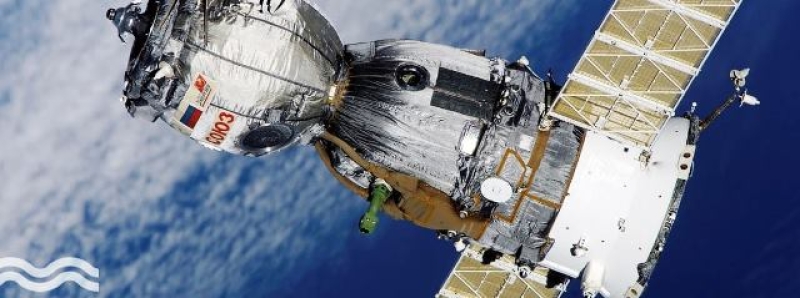- CA Yunus pays homage to Liberation War martyrs on Victory Day |
- Bangladesh capital market extends losing streak for second day |
- Bangladesh celebrates Victory Day Tuesday |
- 'Different govts presented history based on their own ideologies': JU VC |
Space Tech Digitises Water Resilience in Basins

Space tech digitises water resilience in basins. - Aqua Tech Newsletter
An initiative between CEO Water Mandate and the European Space Agency (ESA) is combining digital and space technologies to improve data collection and increase understanding of freshwater resources, including water stress, quality, and accessibility.
A cutting-edge digital monitoring platform
The partnership aims to leverage space technologies and innovative digital tools for advancing water security and resilience by offering comprehensive monitoring of global water resources, such as basins, and adding significantly to the data available.
Writing on LinkedIn, ESA's Davide Coppola, explained more: "I am delighted to see the initial outcomes of this initiative, confirming how space technologies, combined with digital tools and IoT, can illuminate water stress drivers and intervention impacts, even in the most remote regions. Our collaboration with the CEO Water Mandate and the Water Resilience Coalition unlocks new opportunities for cross-sectoral cooperation and innovative business models..."
The initiative forms part of CEO Water Mandate's goal to achieve positive water impact in 100 priority basins by 2030. Its ambition is to develop a cutting-edge digital monitoring platform for these water-stressed basins, which will provide actionable insights into water basin conditions, helping businesses track their contributions to water resilience goals.
From COP28 to breakthrough results
The partnership between CEO Water Mandate and the European Space Agency (ESA) announced the first cohort of projects during COP28 in 2023. This marked what the partnership called 'a transformative step in utilising space technologies, digital innovation, and IoT to enhance water basin monitoring'.
Since that time, the projects have proved valuable in producing quality data, including:
• Comprehensive data sets tracking changes in water levels over time and into the future
• Detailed water quality measurements and pollution source identification
• Climate impact modelling to predict future basin conditions
It has also achieved several milestones, including:
• Funding: ESA allocated €1.5 million to fund eight feasibility studies using satellite data and digital monitoring tools to create detailed diagnostics and impact assessments for selected basins
• Global reach: projects span 13 countries, including Colombia, India, Kenya, Morocco, and the US, setting the stage to expand to 100 priority basins
• Corporate engagement: CEO Water Mandate member companies actively contributed to pilot projects, aligning efforts with Net Positive Water Impact (NPWI) monitoring goals
• Pilot partners: eight European companies - Agreed Earth, CLS, Development Seed, eLeaf-52impact, EOMAP, eRay, Krucial, and Marple - participated in pilot projects, showcasing scalable solutions
• Future development: there are plans for expanded corporate support and additional projects
Jason Morrison, head of the CEO Water Mandate and president of the Pacific Institute, highlighted the importance of space technology in water management: "This partnership with ESA is revolutionising access to water-related data. By integrating satellite observations with innovative technologies, we are opening new frontiers in understanding and protecting freshwater resources worldwide."
Space tech already making waves in the water sector
The ESA has invested in companies and products working in many sectors to provide robust data collected via satellite monitoring technologies. Among those sectors, many rely on accurate and reliable water data.
For example, project THIRTSY used satellite-based thermal data developed by Hydrosat to offer crop yield forecasts in order to improve supply chain management. A second tool will promote farm, and water, management, by informing farmers of the best times to irrigate. Optimal irrigation leads to increased production while reducing water consumption.
THIRSTY was able to overcome customers challenges, such as inaccurate data, insufficient geographical coverage, and predictions that arrive too late in the growing season to be operationally useful, by providing accurate, early season forecasts in major European commodity producing countries.
Yield forecast and irrigation management primarily use publicly available satellite data and weather data, alongside Hydrosat's proprietary data.
Optimal irrigation leads to increased production while reducing water consumption
Thermal infrared imagery can reveal precise canopy temperatures, which gives a measure of evapotranspiration and photosynthetic activity in leaves. This reveals any water stress well before any damage becomes visible.
Other projects have looked at coastal areas to measure water levels, soil erosion and flooding, among other things to help predict future flooding risks and other water-related scenarios. This can predict the future position of the coastline and improve planning to mitigate such events. This project, CORISCLIM, uses four different satellite systems:
• Radar altimetry: for the dynamics of the oceans (change in sea level, waves, storm surges, tides)
• Optical imagery: for the coastal shoreline and erosion
• Radar imagery: for the terrestrial digital elevation model
• Telemetry & GNSS: for vertical land motion
- Aqua Tech Newsletter

